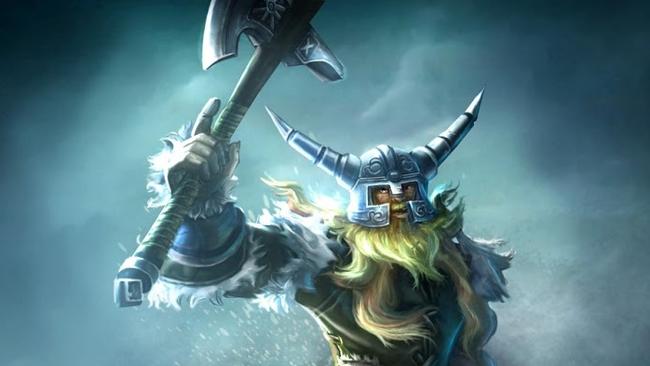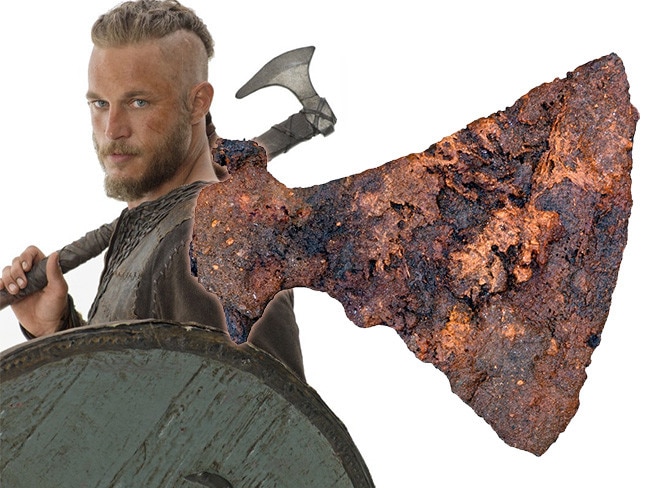Viking burial site in Denmark contained a warrior — and his enormous axe
THE Viking ‘berserker’ warrior has long been considered a myth — but the discovery of an enormous battle-axe at a burial site in Denmark suggests otherwise.

IT seems there’s some truth in the myths after all. Archaeologists in Denmark have found the burial site of a Viking ‘berserker’ warrior — complete with an oversized battle axe.
Like the iconic horns on their helmets, the image of a raging Viking wading through his enemies with an enormous axe has long been regarded as the product of overactive artistic imaginations.
Now it appears not.
One of the biggest Viking axes ever has been found inside a recently excavated dødehuse (death house) in south west Denmark, a type of tomb with separate timber ‘rooms’.
It was the sole possession found among the bones of a particularly strong man.
“It’s a very large axe and would have been a formidable weapon,” says excavation leader Kirsten Nelleman Nielsen. “People across Europe feared this type of axe, which at the time was known as the Dane Axe — something like the ‘machine gun’ of the Viking Age.”
His findings, Dead and buried in the Viking Age, have been published by the Saxo Institute at the University of Copenhangen.
The axe is unadorned, suggesting it was a real weapon of war and not ceremonial.
That it was the only object buried with him also suggests he saw himself to be a warrior above all else.
“It’s a bit extraordinary — it’s much bigger and heavier than the other axes. It would have had a very long handle, and it took both hands to use it,” Nielsen is quoted by Live Science as saying.

HOUSE OF THE DEAD
News service ScienceNordic reports the tomb is part of an extensive burial ground in the Danish district of Harup.
This particular dødehuse was first found in 2012 when engineers building a highway stumbled upon the buried 13m by 4m timber structure.
Inside were three graves, all dating back to 950AD.
“The finds in the tomb confirm that there was a man and a woman in the main part and another man in the back,” Nielsen states.
WITCH BLADE: Tracing the source of ‘magic’ medieval steel
The couple appear to have been a lord and lady. The third body belonged to the warrior.
Goods found with the man and woman appear to have come from all over Europe.
“We’ve also found Baltic ceramics in the form of a clay vessel and silver coins from what is today Afghanistan, so the residents must have been quite international,” archaeologist Henriette Lyngstrøm from the University of Copenhagen, Denmark, is reported as saying.

POWER COUPLE
Where the warrior was buried with his axe, the woman found in the dødehuse’s second room was interred with a set of keys.
“One is a symbol of her power and status as a great lady, the other fits a small square shrine that was also buried with her and is quite rare,” Nielsen told ScienceNordic.
She had been buried inside a wagon of a type believed used by nobility. Combined with the markings on the grave itself, these objects suggests she and the man buried along side her must have held high status.
RELATED: Can you decode this sword’s mysterious message?
A ‘normal’ sized battle axe was found with this man, along with ceramics from the Baltics and two silver coins from Afghanistan.
“It’s very special that the man and woman’s graves are marked by the same tomb or palisade. It’s unusual that we’re able to establish that the man and woman were equals with such certainty,” Nielsen says.
This bursts the myth that Vikings were a male-dominated society.
“Women may easily have been very powerful. Many women were buried in rich clothes with many expensive grave gifts, which all indicate a high position. These women were not buried in an inferior way to men,” Lyngstrøm says.




